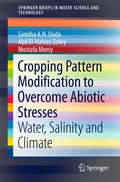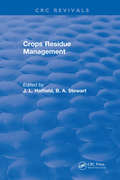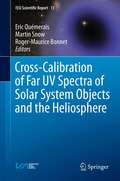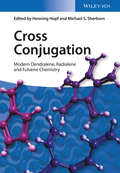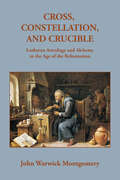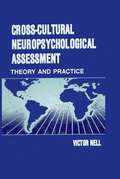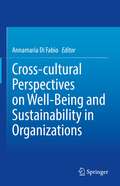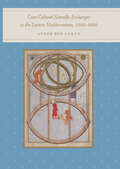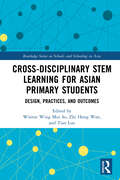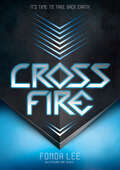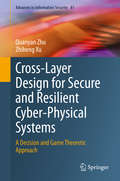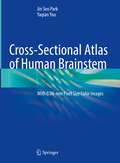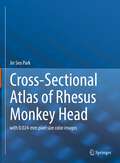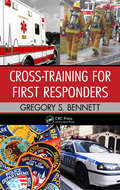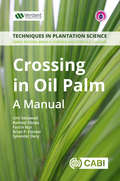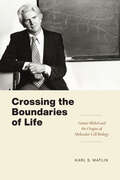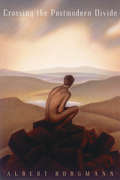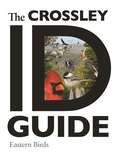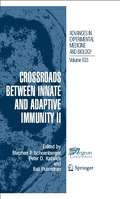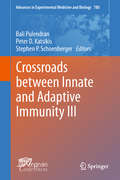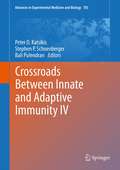- Table View
- List View
Cropping Pattern Modification to Overcome Abiotic Stresses: Water, Salinity and Climate (SpringerBriefs in Water Science and Technology)
by Abd El-Hafeez Zohry Samiha A. H. Ouda Mostafa MorsyThis book provides state-of-the art analysis, never done before in Egypt, on agro-climatic zones level. This study deals with how the national cropping pattern can be modified to overcome abiotic stresses, such as water scarcity, induced salinity and climate change to reduce their negative effects on food production. To this end, different cropping patterns are suggested. This study can be a framework for other developing countries to be used in quantifying and filling the gap in their knowledge about practices that can help in increasing their food security through increasing food production. Furthermore, the study is useful for policy makers to help them in their future plans and policies.
Crops Residue Management
by J. L. HatfieldRecent changes in the Conservation Compliance Plans for farmers shows the need for improved information on the effective management of crop residues. Residue management requires an understanding of the crop, soil, and climate in which the farming system is located. In this volume, the strategies for effective residue management are described for each region of the country to provide a comparison of the regional differences. The chapters not only describe the knowledge in each region but also suggest some of the needed areas of research required to develop an improved understanding of the processes involved in effective residue management.
Cross-Calibration of Far UV Spectra of Solar System Objects and the Heliosphere (ISSI Scientific Report Series #13)
by Roger-Maurice Bonnet Eric Quémerais Martin SnowThis book is the result of a working group sponsored by ISSI in Bern, which was initially created to study possible ways to calibrate a Far Ultraviolet (FUV) instrument after launch. In most cases, ultraviolet instruments are well calibrated on the ground, but unfortunately, optics and detectors in the FUV are very sensitive to contaminants and it is very challenging to prevent contamination before and during the test and launch sequences of a space mission. Therefore, ground calibrations need to be confirmed after launch and it is necessary to keep track of the temporal evolution of the sensitivity of the instrument during the mission. The studies presented here cover various fields of FUV spectroscopy, including a catalog of stellar spectra, datasets of Moon Irradiance, observations of comets and measurements of the interplanetary background. Detailed modelling of the interplanetary background is presented as well. This work also includes comparisons of older datasets with current ones. This raises the question of the consistency of the existing datasets. Previous experiments have been calibrated independently and comparison of the datasets may lead to inconsistencies. The authors have tried to check that possibility in the datasets and when relevant suggest a correction factor for the corresponding data.
Cross Conjugation: Modern Dendralene, Radialene and Fulvene Chemistry
by Henning Hopf Michael S. SherburnFilling a gap in the market, this handbook provides a comprehensive overview of the fascinating and expanding field of cross-conjugated molecules, their chemistry, synthesis and properties. The editor is one of the world's leading scientists in the field, and has assembled here a team of experts to discuss different classes of molecules, as well as the use of cross-conjugation for organic synthesis and applications in electronic systems and material science.
Cross, Constellation, and Crucible: Lutheran Theology and Alchemy in the Age of the Reformation
by John Warwick MontgomeryOriginally appearing in the Transactions of the Royal Society of Canada, 1963, this book follows the lead of Dr. John Warwick Montgomery, who traces the parallel paths of the two major paradigm shifts of the early modern era, the Copernican Revolution and the Protestant Reformation. Along the way, he delivers well-researched insights into the surprisingly close relationship between religion and science in both their day and ours.
Cross-Cultural Neuropsychological Assessment: Theory and Practice
by Victor NellThis is a book for all neuropsychologists who are called upon to assess culturally different clients--with very few exceptions today, this means every neuropsychologist. In Minneapolis as in Oslo, migrant and refugee minorities raise assessment and test validity problems that cannot be ignored. To deal realistically with the problem of doing neuropsychological assessments without norms, Nell describes the principles of a "behavioral neuropsychology," and then sets out interview, test, and interpretation methods that will allow clinicians to produce valid and prognostically accurate assessments. For working neuropsychologists, this is an intensely practical, how-to-do-it book. But unlike other hands-on guides, it lays an impressive historical and theoretical foundation for the practice of cross-cultural neuropsychology. It thus speaks to serious practitioners who need to be certain that their assessment findings are not only correct, but also sufficiently well-grounded to stand up to professional scrutiny and to forensic testing in a court of law.
Cross-cultural Perspectives on Well-Being and Sustainability in Organizations
by Annamaria Di FabioThis book explores a new area of psychology of sustainability and sustainable development with specific focus on organizations, and introduces a range of advanced perspectives for healthy business, harmonization and decent work. Split into two parts, the first half presents cross-cultural contributions that study in depth the benefits and drawbacks of sustainability, while the second half discusses theoretical approaches and empirical research that offer new prospects for innovation in prevention science. Gathering research from leading scholars and researchers from around the globe, this book offers an essential reference guide that will benefit researchers, professionals, students, and policy makers interested in promoting better business harmony and sustainability.
Cross-Cultural Scientific Exchanges in the Eastern Mediterranean, 1560–1660
by Avner Ben-ZakenAvner Ben-Zaken reconsiders the fundamental question of how early modern scientific thought traveled between Western and Eastern cultures in the age of the so-called Scientific Revolution. Through five meticulously researched case studies—in which he explores how a single obscure object or text moved in the Eastern world—Ben-Zaken reveals the intricate ways that scientific knowledge moved across cultures. His diligent exploration traces the eastward flow of post-Copernican cosmologies and scientific discoveries, showing how these ideas were disseminated, modified, and applied to local cultures.Never before has a student of scientific traffic in the Mediterranean taken such pains to see precisely which instruments, books, and ideas first appeared where, in whose hands, by what means, and with what implications. In doing so, Ben-Zaken challenges accepted views of Western primacy in this fruitful exchange. He shows not only how Islamic cultures benefited from European scientific knowledge but also how Eastern understanding of classical Greek texts informed developments in the West.Ben-Zaken’s mastery of different cultures and languages uniquely positions him to tell this intriguing story. His findings reshape our understanding of scientific discourse in this critical period and contribute to the growing field of cross-cultural Christian-Muslim studies.
Cross-disciplinary STEM Learning for Asian Primary Students: Design, Practices, and Outcomes (Routledge Series on Schools and Schooling in Asia)
by So, Winnie Wing Mui Zhi Hong Wan Tian LuoGiven the importance of student learning in the various types and integration of STEM education, this book provides a landscape of cross-disciplinary STEM learning in Asian primary schools, and a systematic overview of design, practices, and outcomes of STEM learning implementation. Science, Technology, Engineering and Mathematics (STEM) has continued to attract attention worldwide, and there have been calls for the promotion of STEM education in primary schools to nurture students to meet the needs of societies in terms of innovation and technology development. Since STEM is complex in nature and is related to various disciplines, the effort of a single discipline may not be as effective as cross-disciplinary efforts. This edited volume, involving an Asian team of authors, examines how cross-disciplinary STEM learning can be designed for students to achieve viable outcomes, and what opportunities and challenges have been offered to the next generation to equip them with the necessary skills, knowledge, and ways of thinking, as well as attitudes and values for lifelong learning. A resourceful text for students, researchers, and practitioners interested in the rich development of STEM education and practical methods for a variety of learning approaches from elementary to secondary education has been provided.
Cross Fire: An Exo Novel (The Exo Novels)
by Fonda Lee“Cross Fire, like Exo, is a knockout . . . Lee’s recalibrating of traditional YA dystopian narratives continues to be a strength.” —MuggleNetIt’s time to take back Earth.Earth’s century of peace as a colony of an alien race has been shattered. As the alien-run government navigates peace talks with the human terrorist group Sapience, Donovan tries to put his life back together and return to his duty as a member of the security forces. But a new order comes from the alien home planet: withdraw. Earth has proven too costly and unstable to maintain as a colony, so the aliens, along with a small selection of humans, begin to make plans to leave. As word of the withdrawal spreads through the galaxy, suddenly Earth becomes vulnerable to a takeover from other alien races. Aliens who do not seek to live in harmony with humans, but will ravage and destroy the planet.As a galactic invasion threatens, Donovan realizes that Sapience holds the key that could stop the impending war. Yet in order to save humankind, all species on Earth will have to work together, and Donovan might just have to make the ultimate sacrifice to convince them.“Brutal, intense action scenes . . . ultimately wins through to a hard-fought triumph.” —Kirkus Reviews“Cross Fire is a solid sequel to Exo and maintains the exciting pace, twisty plot, and ethical quandaries.” —Fantasy Literature
Cross-Layer Design for Secure and Resilient Cyber-Physical Systems: A Decision and Game Theoretic Approach (Advances in Information Security #81)
by Quanyan Zhu Zhiheng XuThis book introduces a cross-layer design to achieve security and resilience for CPSs (Cyber-Physical Systems). The authors interconnect various technical tools and methods to capture the different properties between cyber and physical layers. Part II of this book bridges the gap between cryptography and control-theoretic tools. It develops a bespoke crypto-control framework to address security and resiliency in control and estimation problems where the outsourcing of computations is possible. Part III of this book bridges the gap between game theory and control theory and develops interdependent impact-aware security defense strategies and cyber-aware resilient control strategies.With the rapid development of smart cities, there is a growing need to integrate the physical systems, ranging from large-scale infrastructures to small embedded systems, with networked communications. The integration of the physical and cyber systems forms Cyber-Physical Systems (CPSs), enabling the use of digital information and control technologies to improve the monitoring, operation, and planning of the systems. Despite these advantages, they are vulnerable to cyber-physical attacks, which aim to damage the physical layer through the cyber network.This book also uses case studies from autonomous systems, communication-based train control systems, cyber manufacturing, and robotic systems to illustrate the proposed methodologies. These case studies aim to motivate readers to adopt a cross-layer system perspective toward security and resilience issues of large and complex systems and develop domain-specific solutions to address CPS challenges.A comprehensive suite of solutions to a broad range of technical challenges in secure and resilient control systems are described in this book (many of the findings in this book are useful to anyone working in cybersecurity). Researchers, professors, and advanced-level students working in computer science and engineering will find this book useful as a reference or secondary text. Industry professionals and military workers interested in cybersecurity will also want to purchase this book.
Cross-Sectional Atlas of Human Brainstem: With 0.06-mm Pixel Size Color Images
by Jin Seo Park Yaqian YouThis is superb cross-sectional atlas of human brainstem, which based on color images with 0.06-mm pixel size of Visible Korean. It wears 48 bits true color and covers almost all nuclei and tracts in the brainstem. In this atlas, whole shapes and locations of each nucleus and tract can be identified in not only three parts (midbrain, pons, and medulla oblongata) of the brainstem but also the junctions of the three parts.This book will provide a detailed topographical data for scientific research that contains morphological and functional studies of the human brainstem for neuroanatomist and neuroscientist. Also, this book will provide a detailed reference for neurologist to determining the precise location of the small and complicated structure and lesions.
Cross-Sectional Atlas of Rhesus Monkey Head: with 0.024-mm pixel size color images
by Jin Seo ParkThe Visible Monkey is the first trial to obtain high-quality and real-color sectioned images of a rhesus monkey’s whole body (intervals, 0.05 mm (head) and 0.5 mm (body except head); pixel size, 0.024 mm X 0.024 mm; color depth, 48 bits color). This color atlas sets a new standard in rhesus monkey neuroanatomy by presenting around 400 ultrathin sectioned images of the head, including the brain, and whole body of the rhesus monkey. The image enabled observations of detailed anatomical structures, thanks to high-resolution and real-color sectioned images of the monkey unlike the stained sections and magnetic resonance images (MRI). Furthermore, anterior commissure-posterior commissure reference system employed for this purpose is clearly explained for the readers, and structures are fully annotated in the horizontal, coronal, and sagittal planes. Recent advances in 3 Tesla MRI and tractography from MRI have considerably enhanced imaging of the monkey brain, thereby impacting on both neuroscience research and clinical practice. Moreover, the information gained from initiatives involving photography of thin slices of cross-sectional images includes enriched knowledge of neuroanatomy and thereby facilitated the interpretation of such ultra-high-field resolution images. These exquisite images contained within this atlas will be invaluable in providing both researchers and clinicians with important new insights.
Cross-Training for First Responders
by Gregory BennettThe tragedy that occurred in the United States on September 11, 2001 brought enhanced emergency preparedness among first responders to the forefront of public awareness. Since those events � and despite significant progress made in many of the areas previously deemed deficient � some response areas are still woefully inadequate. Cross-Training for
Crossing in Oil Palm: A Manual (Techniques in Plantation Science #6)
by Umi Setiawati Baihaqi Sitepu Fazrin Nur Brian Forster Sylvester DeryOil palm is the world's most important oil crop and crossing is used extensively in the production of commercial seed, breeding and genetic studies. This book illustrates crossing techniques to maximise success and safeguard purity, enabling the production of high quality seeds to grow-on as planting material and in breeding superior cultivars. Presenting sound practices based on scientific innovation in plant breeding, this guide provides techniques integrated with expertise and application of sustainable aspects of agronomy and crop protection. Promoting green, eco-friendly agriculture, this book covers: Biology and genetics, germplasm, target traits and commercial crossing Health and safety considerations in the field and laboratory Pollen collection and storage, pollen viability testing Isolation of the female inflorescence Pollination of the female inflorescence Commercial Tenera production Based on experience and protocols, this is an invaluable manual for students and researchers in agriculture, plant breeders, growers and end users interested in the practicalities of oil palm crossing for breeding and commercial seed production. It provides a resource for training, a knowledge base for people new to oil palm and a reference guide for managers, to ensure best practices in maximising sustainability and production of this important crop.
Crossing in Oil Palm: A Manual (Techniques in Plantation Science #6)
by Umi Setiawati Baihaqi Sitepu Fazrin Nur Brian Forster Sylvester Dery Peter D. CaligariOil palm is the world's most important oil crop and crossing is used extensively in the production of commercial seed, breeding and genetic studies. This book illustrates crossing techniques to maximise success and safeguard purity, enabling the production of high quality seeds to grow-on as planting material and in breeding superior cultivars. Presenting sound practices based on scientific innovation in plant breeding, this guide provides techniques integrated with expertise and application of sustainable aspects of agronomy and crop protection, alongside information and imaging technology. Promoting green, eco-friendly agriculture, this book covers: biology and genetics, germplasm, target traits and commercial crossing; health and safety considerations in the field and laboratory; pollen collection and storage, pollen viability testing, and pollination; isolation of the female inflorescence; and commercial tenera production. Based on experience and protocols, this is an invaluable manual for students and researchers in agriculture, plant breeders, growers and end users interested in the practicalities of oil palm crossing for breeding and commercial seed production
Crossing the Boundaries of Life: Günter Blobel and the Origins of Molecular Cell Biology (Convening Science: Discovery at the Marine Biological Laboratory)
by Karl S. MatlinA close look at Günter Blobel’s transformative contributions to molecular cell biology. The difficulty of reconciling chemical mechanisms with the functions of whole living systems has plagued biologists since the development of cell theory in the nineteenth century. As Karl S. Matlin argues in Crossing the Boundaries of Life, it is no coincidence that this longstanding knot of scientific inquiry was loosened most meaningfully by the work of a cell biologist, the Nobel laureate Günter Blobel. In 1975, using an experimental setup that did not contain any cells at all, Blobel was able to target newly made proteins to cell membrane vesicles, enabling him to theorize how proteins in the cell distribute spatially, an idea he called the signal hypothesis. Over the next twenty years, Blobel and other scientists were able to dissect this mechanism into its precise molecular details. For elaborating his signal concept into a process he termed membrane topogenesis—the idea that each protein in the cell is synthesized with an "address" that directs the protein to its correct destination within the cell—Blobel was awarded the Nobel Prize in Physiology or Medicine in 1999. Matlin argues that Blobel’s investigative strategy and its subsequent application addressed a fundamental unresolved dilemma that had bedeviled biology from its very beginning—the relationship between structure and function—allowing biology to achieve mechanistic molecular explanations of biological phenomena. Crossing the Boundaries of Life thus uses Blobel’s research and life story to shed light on the importance of cell biology for twentieth-century science, illustrating how it propelled the development of adjacent disciplines like biochemistry and molecular biology.
Crossing the Boundaries of Life: Günter Blobel and the Origins of Molecular Cell Biology (Convening Science: Discovery at the Marine Biological Laboratory)
by Karl S. MatlinA close look at Günter Blobel’s transformative contributions to molecular cell biology. The difficulty of reconciling chemical mechanisms with the functions of whole living systems has plagued biologists since the development of cell theory in the nineteenth century. As Karl S. Matlin argues in Crossing the Boundaries of Life, it is no coincidence that this longstanding knot of scientific inquiry was loosened most meaningfully by the work of a cell biologist, the Nobel laureate Günter Blobel. In 1975, using an experimental setup that did not contain any cells at all, Blobel was able to target newly made proteins to cell membrane vesicles, enabling him to theorize how proteins in the cell distribute spatially, an idea he called the signal hypothesis. Over the next twenty years, Blobel and other scientists were able to dissect this mechanism into its precise molecular details. For elaborating his signal concept into a process he termed membrane topogenesis—the idea that each protein in the cell is synthesized with an "address" that directs the protein to its correct destination within the cell—Blobel was awarded the Nobel Prize in Physiology or Medicine in 1999. Matlin argues that Blobel’s investigative strategy and its subsequent application addressed a fundamental unresolved dilemma that had bedeviled biology from its very beginning—the relationship between structure and function—allowing biology to achieve mechanistic molecular explanations of biological phenomena. Crossing the Boundaries of Life thus uses Blobel’s research and life story to shed light on the importance of cell biology for twentieth-century science, illustrating how it propelled the development of adjacent disciplines like biochemistry and molecular biology.
Crossing the Boundaries of Life: Günter Blobel and the Origins of Molecular Cell Biology (Convening Science: Discovery at the Marine Biological Laboratory)
by Karl S. MatlinA close look at Günter Blobel’s transformative contributions to molecular cell biology. The difficulty of reconciling chemical mechanisms with the functions of whole living systems has plagued biologists since the development of cell theory in the nineteenth century. As Karl S. Matlin argues in Crossing the Boundaries of Life, it is no coincidence that this longstanding knot of scientific inquiry was loosened most meaningfully by the work of a cell biologist, the Nobel laureate Günter Blobel. In 1975, using an experimental setup that did not contain any cells at all, Blobel was able to target newly made proteins to cell membrane vesicles, enabling him to theorize how proteins in the cell distribute spatially, an idea he called the signal hypothesis. Over the next twenty years, Blobel and other scientists were able to dissect this mechanism into its precise molecular details. For elaborating his signal concept into a process he termed membrane topogenesis—the idea that each protein in the cell is synthesized with an "address" that directs the protein to its correct destination within the cell—Blobel was awarded the Nobel Prize in Physiology or Medicine in 1999. Matlin argues that Blobel’s investigative strategy and its subsequent application addressed a fundamental unresolved dilemma that had bedeviled biology from its very beginning—the relationship between structure and function—allowing biology to achieve mechanistic molecular explanations of biological phenomena. Crossing the Boundaries of Life thus uses Blobel’s research and life story to shed light on the importance of cell biology for twentieth-century science, illustrating how it propelled the development of adjacent disciplines like biochemistry and molecular biology.
Crossing the Postmodern Divide
by Albert BorgmannIn this eloquent guide to the meanings of the postmodern era, Albert Borgmann charts the options before us as we seek alternatives to the joyless and artificial culture of consumption. Borgmann connects the fundamental ideas driving his understanding of society's ills to every sphere of contemporary social life, and goes beyond the language of postmodern discourse to offer a powerfully articulated vision of what this new era, at its best, has in store. This] thoughtful book is the first remotely realistic map out of the post modern labyrinth. OCoJoseph Coates, "The Chicago Tribune" Rather astoundingly large-minded vision of the nature of humanity, civilization and science. OCo"Kirkus Reviews""
The Crossley ID Guide: Eastern Birds (The Crossley ID Guides)
by Richard CrossleyA revolution in birding and field guidesThis stunningly illustrated book from acclaimed birder and photographer Richard Crossley revolutionizes field guide design by providing the first real-life approach to identification. Whether you are a beginner, expert, or anywhere in between, The Crossley ID Guide will vastly improve your ability to identify birds.Unlike other guides, which provide isolated individual photographs or illustrations, this is the first book to feature large, lifelike scenes for each species. These scenes—640 in all—are composed from more than 10,000 of the author's images showing birds in a wide range of views--near and far, from different angles, in various plumages and behaviors, including flight, and in the habitat in which they live. These beautiful compositions show how a bird's appearance changes with distance, and give equal emphasis to characteristics experts use to identify birds: size, structure and shape, behavior, probability, and color. This is the first book to convey all of these features visually--in a single image--and to reinforce them with accurate, concise text. Each scene provides a wealth of detailed visual information that invites and rewards careful study, but the most important identification features can be grasped instantly by anyone.By making identification easier, more accurate, and more fun than ever before, The Crossley ID Guide will completely redefine how its users look at birds. Essential for all birders, it also promises to make new birders of many people who have despaired of using traditional guides.Revolutionary. This book changes field guide design to make you a better birderA picture says a thousand words. The most comprehensive guide: 640 stunning scenes created from 10,000 of the author's photographsReality birding. Lifelike in-focus scenes show birds in their habitats, from near and far, and in all plumages and behaviorsTeaching and reference. The first book to accurately portray all the key identification characteristics: size, shape, behavior, probability, and colorPractice makes perfect. An interactive learning experience to sharpen and test field identification skillsBird like the experts. The first book to simplify birding and help you understand how to bird like the bestAn interactive website—www.crossleybirds.com—includes expanded captions for the plates and species updates
Crossroads: Environmental Priorities For The Future
by James Gustave Speth Barry Commoner Robert Boyle Cynthia Wilson Richard S. Booth Amos EnoThe environmental movement today is at a critical crossroads. Crossroads: Environmental Priorities for the Future is an in-depth assessment of the movement's successes and failures, and also offers prescriptions for the future. It includes contributions from some of the country's top environmental leaders and activists, including Barry Commoner, Stewart Udall, William K. Reilly, Gus Speth, Jay Hair, Lois Gibbs, Michael Frome, Chuck Little, and William Futrell.
Crossroads between Innate and Adaptive Immunity II (Advances in Experimental Medicine and Biology #633)
by Bali Pulendran Peter D. Katsikis Stephen P. SchoenbergerAegean Conferences is an independent, nonprofit, educational organization directed and managed by the scientific community. The board is made up of nine researchers/scientists in various disciplines from Harvard, Brown, University of Pennsylvania, UCSD, Princeton, Biovista and the Foundation for Biomedical Research Academy of Athens. The board both invites and approves unsolicited proposals for Conferences in all fields of Science, Engineering, Arts, and Humanities. The purpose of the Conferences is to bring together individuals with common interests to examine the emerging and most advanced aspects of their particular field. This volume will include mini-reviews derived from work to be presented at the Aegean Conference: Second Crossroads between Innate and Adaptive Immunity, in Crete, Greece, June 17-22, 2007. This meeting is designed to serve as a forum to discuss the most recent progress in complement research as it pertains to human disease pathogenesis and therapeutics. The rapid pace of development in complement basic research and the advent and application of new experimental approaches in this field have now allowed us to take an integrated view of the in vivo biology of the complement system. The availability of new reagents (e.g. synthetic and recombinant inhibitors) and animal models (e.g. transgenic and knockout mice) has enabled us to address, in an in vivo setting, its involvement in various pathophysiological conditions. Such studies are shedding new light on the pathogenetic mechanism of complement-related diseases such as autoimmune diseases and inflammatory tissue damage as well as defining new areas of high interest such as the developmental biology of complement. They also provide the basis for developing new therapeutic strategies for these diseases through manipulation of in vivo complement activity. This volume will serve as a resource where the latest development in these specific areas will be discussed in a more focused and detailed manner.
Crossroads between Innate and Adaptive Immunity III (Advances in Experimental Medicine and Biology #780)
by Bali Pulendran Peter D. Katsikis Stephen P. SchoenbergerThis volume presents a collection of reviews derived from work presented at the Aegean Conference: “3rd Crossroads between innate and adaptive immunity” which occurred during September 27 - October 2, 2009 at the Minoa Palace Conference Center in Chania, Crete, Greece. This meeting was the third in a series, and assembled a team of scientists working on mechanisms by which the innate immune system of the host senses pathogens, the cellular and signaling networks that orchestrate the innate response and antigen presentation and adaptive immunity. The various facets of the innate response, including dendritic cells, T cells, B cells, NK cells, NK-T cells and the complement cascade during the host response to pathogens and tumors is only now starting to be elucidated. The respective fields that focus on these immune cells and molecules have tended to be relatively compartmentalized, and yet emerging evidence points to the interconnectedness of these facets in coordinating the innate response, and its subsequent impact on the adaptive response. The goal of this conference was to initiate cross-talk between these diverse immunological fields, and promote and facilitate discussion on the interactions between the innate immune response and the adaptive immune response and ultimately facilitate collaboration between these areas of study. Following on the footsteps of the outstanding success of its precursors, the “3rd Crossroads between Innate and Adaptive Immunity” Aegean Conference was highly successful in bringing together and connecting scientists and experts from around the world to address critical areas of Innate and Adaptive immunity. This volume will include mini-reviews derived from work to be presented at the Aegean Conference: Second Crossroads between Innate and Adaptive Immunity, in Crete, Greece, June 17-22, 2007. This meeting is designed to serve as a forum to discuss the most recent progress in complement research as it pertains to human disease pathogenesis and therapeutics. The rapid pace of development in complement basic research and the advent and application of new experimental approaches in this field have now allowed us to take an integrated view of the in vivo biology of the complement system. The availability of new reagents (e.g. synthetic and recombinant inhibitors) and animal models (e.g. transgenic and knockout mice) has enabled us to address, in an in vivo setting, its involvement in various pathophysiological conditions. Such studies are shedding new light on the pathogenetic mechanism of complement-related diseases such as autoimmune diseases and inflammatory tissue damage as well as defining new areas of high interest such as the developmental biology of complement. They also provide the basis for developing new therapeutic strategies for these diseases through manipulation of in vivo complement activity. This volume will serve as a resource where the latest development in these specific areas will be discussed in a more focused and detailed manner.
Crossroads Between Innate and Adaptive Immunity IV (Advances in Experimental Medicine and Biology #785)
by Bali Pulendran Peter D. Katsikis Stephen P. SchoenbergerThis volume presents a collection of reviews derived from work presented at the Aegean Conference: “4th Crossroads between innate and adaptive immunity”. This meeting was the fourth in a series, and assembled a team of scientists working on mechanisms by which the innate immune system of the host senses pathogens, the cellular and signaling networks that orchestrate the innate response and antigen presentation and adaptive immunity. The importance of the crosstalk between innate immunity and the adaptive immune response has only recently started to be appreciated. Although it is well recognized that dendritic cells, NK cells, NK-T cells and T cells are all critical for the host response to pathogens, the respective fields that study the biology of these immune cells tend to exist in parallel worlds with minimum exchange of information and ideas. This fragmentation hinders the integration of these fields towards a unified theory of host response. The Aegean Conference “Crossroads between Innate and Adaptive Immunity” brought together leading international scientists and experts to address critical areas of Innate and Adaptive immunity something necessary for the development of more efficient scientific exchange and crosspollination between these fields. This conference attracted scientists from all over the world to discuss their latest findings on the various aspects of Innate and Adaptive immunity. The conference had limited participation and a scientific and social program that maximized scientific interchange through lecture presentations, poster sessions and informal discussions.
